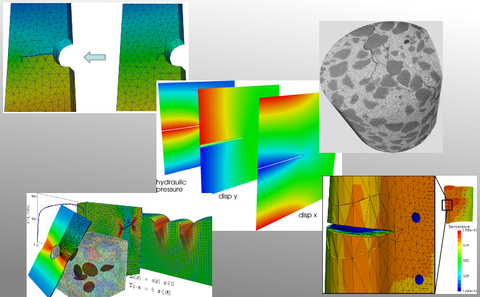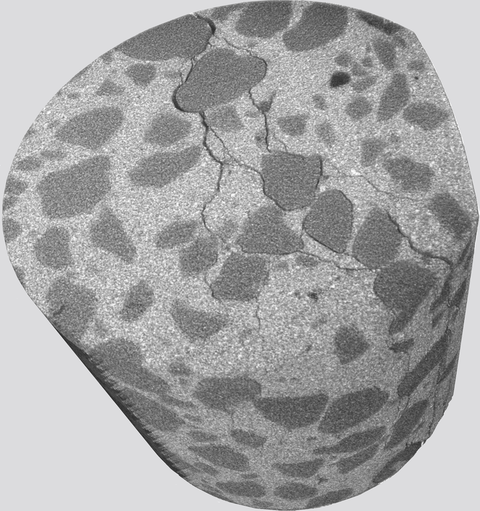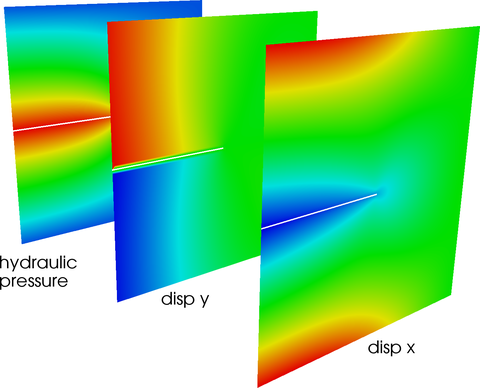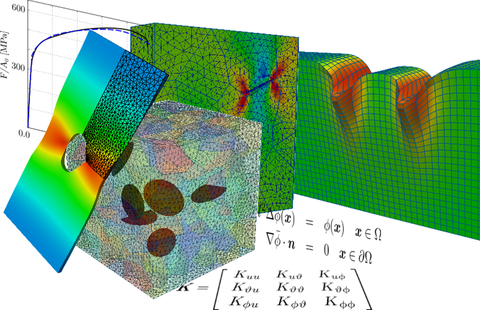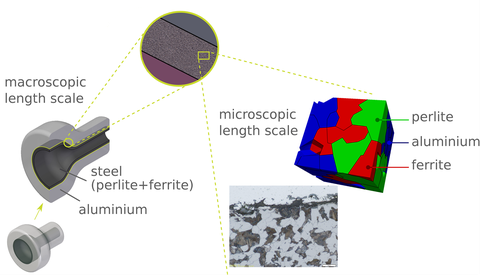Research Field "Damage and Fracture Mechanics"
In most cases buildings, engineering components and materials fail due to damage and fracture mechanical processes. However, most materials react quite differently concerning their fracture mechanical properties. To be able to predict when and unde what conditions a material failure occurs, precise models and corresponding computational methods are required. Based on the eXtended Finite Element Method (XFEM) and appropriate material models in this research field methods are developed to efficiently and accurately compute when and how modern materials break.
Research Projects
Contact:
Jian Sun
Cooperation Partner:
Institut für Kontinuumsmechanik (IKM), Leibniz-Universität Hannover
Abstract:
Many expensive engineering parts and components such as e.g. turbine blades of aero engines or Diesel engines of ships or locomotives are exposed to very high thermomechanical loads. In case of damage due to the monetary costs as well as environmental aspects a regeneration of the engineering part is often desirable. This regeneration may have some influence on the initiation of new cracks and thus on the remaining life time of the engineering part. In project C5 of the CRC 871 a spatial and temporal multiscale method is developed for the calculation of the remaining life time of thermomechanically highly loaded parts. The crack propagation simulations in 3D are based on the eXtended Finite Element Method in combination with the multiscale projection method. Due to thermal strains and cyclic loadings crack face contact including heat transfer may occur and needs to be included in the model. Crack propagation is considered using a propagation criterion based on a nonlocal damage model. The influence of the strongly coupled thermomechanical strain on the crack propagation is demonstrated using the example of a compressor blisk and a turbine blad which is exposed to extreme temperature gradients. In cooperation with many other projects of the CRC 871 realistic boundary conditions can be obtained and used for the simulations and the results can be comared and validated with experimental data.
Contact:
Rohan Patel
Cooperation Partner:
Institut für Kontinuumsmechanik (IKM), Leibniz-Universität Hannover
Abstract:
Compared to normal-strength concrete, high-strength concrete exhibits a denser and improved microstructure. The material behaviour of high-strength concrete under monotonically increasing external loads is significantly different compared to the material behaviour of normal-strength concrete. It is mainly influenced by optimized properties of the cement or the binder agent and the interfacial transition zone. Concerning fatigue properties of high-strength concrete and normal-strength concrete until now it is unclear how the damage processes differ due to their different microstructures.
As a consequence, within this joint project together with Dr.-Ing Nadja Oneschkow, Institute of Building Materials, Leibniz Universität Hannover, the degradation mechanisms of high-strength concrete under cyclic loading will be examined, described and modelled. In particular, the nucleation and propagation of cracks within the different phases of degradation will be investigated. Based on a stepwise methodology the influence on the fatigue behaviour of typical concrete technology measures to produce high-strength concrete will be analysed systematically. The degradation mechanisms will be determined using different damage indicators. Differences will be elaborated and quantified while the application of the damage indicators within an experimental-virtual-lab will be investigated and evaluated. In addition, high resolution imaging processes will be applied to observe different crack states and to relate them to the development of the damage indicators within the fatigue process.
Within this conjoint project an experimental/building material subproject and a theoretical/computational subproject are planned. The two subprojects cooperate intensively regarding contents and methodology. Damage processes happening on a very small scale can sometimes be observed experimentally only on a much larger scale. Knowledge about these damage processes will be gained by a scale transitioned modelling calibrated by experimental results which allows for drawing conclusions about processes on the fine scale. To realize this, the multiscale projection method in combination with the XFEM and non-local damage for the simulation of crack nucleation and dynamic crack propagation on multiple scales will be used. From the close cooperation between the Institute for Building Materials and the Institute for Mechanics and Shell Structures and from the resulting close networking of experiment and computation, the components of an Experimental-Virtual-Lab (EVL) will be developed and tested.
Contact:
Alina Juan-Lien Ramirez
Abstract:
The formation of fissures and cracks in rock material induced by flow processes is a relevant process for geotechnical applications, such as geothermal energy production (“fracking”) or oil recovery. The understanding of formation of fissures in building materials induced by flow is also important for assessing the security of coastal building structures. This project aims at analysing the relation between single phase flow processes, such as injection of fluid under high pressure, and patterns of fissures and cracks caused by the flow and the two-way coupling of these processes. For this purpose, a numerical model for the coupled flow and failure propagation is developed that is capable of dealing with the complex and dynamic structures of fractures and fissures and that solves the coupled equations in an efficient way. For this purpose, the crack and fissure formation is dealt with using the XFEM.
Contact:
Tengfei Lyu, Shahbaz Ahmed
Cooperation Partner:
Institut für Kontinuumsmechanik (IKM), Leibniz-Universität Hannover
Abstract:
In metal forming processes a large amount of mechanical work is dissipated due to large plastic deformations. The accompanying temperature rise leads to thermal strains and a change in the material behaviour which can influence the mechanical behaviour during the forming process and the final shape of the part. For this reason it is important to consider temperature effects and heat conduction in the material modelling of the polycrystalline microstructure. The resulting thermomechanical problem exhibits a strong coupling since on the one hand through mechanical deformation heat sources are introduced and on the other hand material parameters may depend on the temperature and also large thermal strains can emerge. Experimentally the temperature influence can be analysed by performing experiments with material specimens at different temperatures. The results can be used to develop a thermomechanical material model for the microstructure. By using homogenisation techniques the macroscopic effective material model developed in period 1 of the CRC/TR73 is extended by temperature effects.
Another critical effect occurring during the forming process is the initiation and propagation of microcracks. This effect leads to a stiffness reduction or even to failure of the entire structure. Therefore it is essential to study the degradation mechanisms of the crystallographic microstructure. A nonlocal damage model is used to account for microcracks. For propagating the crack existing models are extended to nonlinear anisotropic and inelastic materials. Especially a criterion has to be found when cracks collide with grain boundaries. For the case of stable crack growth with a statistical simulation series a representative volume element can be found. This is used to produce a micromechanically motivated stress strain relationship by a homogenisation procedure. With this material response the effective material model of period 1 of the CRC/TR73 is extended. Here it is important to capture the softening effects with a nonlocal damage model. In a last step the two approaches are combined for the construction of a material model capturing thermomechanical effects and cracks on the microstructural level.
Contact:
Martina Baldrich, Felix Töller
Cooperation Partner:
Institut für Kontinuumsmechanik (IKM), Leibniz-Universität Hannover
Abstract:
The overall objective of the collaborative research center "Tailored Forming" (CRC 1153) is to open up the potential for hybrid solid components on the basis of a new tailored manufacturing process using joined semi-finished products. In contrast to existing manufacturing and production processes of hybrid components, in which the joining process takes place during forming or at the end of the production chain, the tailored semi-finished products used in the CRC 1153 are joined before the forming process. Compared to the existing manufacturing process, the simple geometry of semi-finished products facilitates the handling and the reliable production of a material joining zone. The controlled material flow during the subsequent forming process also opens up completely new design possibilities of the resulting joining zone geometry, which cannot be created by conventional joining techniques. In addition, depending on the material combination, the (thermo-mechanical) forming process is expected to improve the joining quality. Based on different metallic materials it should thus be possible in the future to produce complex high-performance components which are not yet producible according to the current state of the art. The precedent joining process also results in manufacturing advantages. By means of the geometric adjustment of the joined semi-finished products to the final component a predistribution of the material is possible. As a result, the material flow and the process-related burr can be significantly reduced.
The topic of project C4 is the multiphysical modelling and simulation of the microstructural behaviour of the joining zone during the tailored forming process. The goal is the determination of the macroscopic, effective, thermomechanical properties of joining zones during and after forming. The macroscopic material model which is developed here as well as the respective material parameters will be used by other projects within the collaborative research center e.g. for macroscopic forming simulations. One of the difficulties in modelling and simulating the microstructure of joining zones of different materials is the possibly very different behaviour of the joint materials. The joining zones sustain rather complex, strongly coupled mechanical, thermal and chemical influences during the joining and forming processes as well as during heat treatment. Diffusion plays an important role for the cohesion of the materials. On the microstructural level the polycrystalline material of the joining zone is modelled. The model will be able to capture the contact and diffusion processes during joining, the thermal and mechanical properties during forming as well as the material behaviour during heat treatment which is responsible for calibrating material properties. A second goal of the material modelling and simulation is the prediction of the material behaviour and of eigenstresses after forming and in the vicinity of joint surfaces as well as close to machined surfaces. In close collaboration with other projects of the CRC 1153 the material models for the microstructure as well as the macroscopic material models will be validated. On the macroscopic level the material models will be used in a couple of other cooperating projects for forming simulations.

